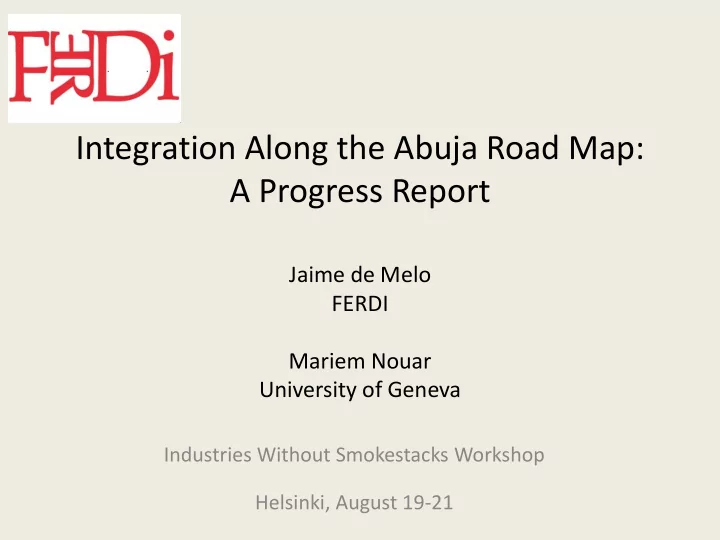

Integration Along the Abuja Road Map: A Progress Report Jaime de Melo FERDI Mariem Nouar University of Geneva Industries Without Smokestacks Workshop Helsinki, August 19-21
Outline Preliminaries Progress at integration: A first look Diversity in Characteristics (economic, geography, culture) Design: Breadth vs. depth The political dimension Trade Patterns, Trade Costs and New Manufactures
Preliminaries/Overview • PTAs (FTAs, RECs) are good politics, but to survive need sound economic basis • Previous surveys (Melo/Tsikata: Critique of Linear integration model; Newfarmer: Regional cooperation) Narrative: • ‘Roots’ of development (intergenerational transmission of development (biological and cultural) • ‘Institutions and Trade’ . Trade strongly depends on domestic institutions (rather than endowments/technology Take Away (from stylized outcome patterns across RECS): o Trade costs are still high (Trust, Institutions) o Trade → Opportunity cost of conflict ↑
Progress at integration: A first look How much progress? Difficult to ascertain • Examples on tariffs in paper EAC (Rwanda) vs ECOWAS (Liberia) • Examples of cooperation in RTAs in Newfarmer (2015) Below a patchwork evaluation (note RECs vs other RTAs) COMESA EAC ECOWAS SACU SADC AMU CEMAC WAMU CEN-SAD ECCAS IGAD Type of agreement CU CU CU CU & M. FTA FTA CU & M. CU & M. Aspired coverage (an * indicates achievement) Currency No Yes Yes Yes(*) No(*) No Yes (*) Yes (*) Goods Yes Yes (*) Yes Yes(*) Yes Yes(*) Yes(*) Yes(*) Services Some Some Some Some Some Some Some Customs Yes Yes Yes Yes Yes Yes Yes Yes Intellectual Property No Yes Yes Yes Yes No Yes Investment Yes Yes Yes Yes Yes Yes Labor Yes Yes Yes Competition Yes Yes Yes Dispute resolution Yes Yes Yes Yes no Yes Govt Procurement Yes Political Federation Yes Yes ECA Index of Integration b/ Index:range: 0 to 1 0.415 0.540 0.509 0.531 0.459 0.395 0.454 0.457
Disparity / heterogeneity (1) • Size dispersion: – Gains from economies of scale – Agglomeration (core-periphery) need for compensation • Per capita income dispersion: – Kenya (K), Uganda (U) both below average world K/L FTA: gains for K, loss for U need for compensation • Natural resource dispersion: -- Effects of shocks are magnified
Disparity / heterogeneity (2) • Strong Intergeneration transmission (biological, cultural) – High biological dispersion persists low trust – ∆ GDP persists – high trade costs • Measures: – Biological: bilateral subpopulation weighted genetic distance – Trust: Ethnolinguistic (or polarization) index • Bilateral trade is negatively correlated with measures on next slides (to be explored further)
Heterogeneity (1): size
Heterogeneity (1): Natural capital
Heterogeneity (2): Genetic distance
Heterogeneity (2): cultural (ELF)
Design: Breadth vs. depth • Narrow: EAC (Rwanda) vs wide: ECOWAS (Liberia). TFTA: too much breadth (large membership)? How Deep is RTA coverage in S-S (and SSA)? COMESA/ECOWAS WTO + /SADC Other S/S (18) Trade-related (6) 0.94 0.79 Investment-related/GATS/TRIPs (4) 0.56 0.31 Domestic trade-related (SPS, TBT, 0.40 0.34 etc.)(5) WTO-X Capital and labour (7) 0.33 0.20 Domestic trade-related (environment, 0.80 0.16 competition, etc.) (5) Others (audiovisual, cultural, 0.27 0.09 cooperation, etc.) (25)
The political dimension • RTA: Eases political tensions (?) – Opportunity cost of conflict up RTAs bring peace (Martin, Mayer, Thoenig) • RTA: trade-off between benefits (address Externalities via regional cooperation) and political costs (common policy is away from preferred national policy.
3 ‘before - after’ Trade outcomes 1. Intra and extra-regional import patterns 2. Gravity-inspired trade costs estimates (approximated by average distance ratio – ADR) – ADR = (average distance of trade ADOT) / (average potential distance of trade ADOTP) 𝑍 𝑝 𝑍 𝑒 – A 𝐸𝑃𝑈𝑄 = 𝑍 𝑋 ; 𝑍 𝑋 = 𝑍 𝑝 + 𝑍 𝑒 – If ADOTP unchanged by RTA ADOT ↓ as countries trade more regionally to exploit reduction in trade costs 3. Destination of new manufactures (HS-4 level) • Following scatters (before and 5 and 10 years after): If ADR ↓ (scatter below 45 ° line) relative costs of trading regionally falling more rapidly than other dimensions
Intra-RTA shares very low for all African RTAs/RECs except ECOWAS, WAEMU, SADC. For all African RECs, 10yrs on, Intra-bloc share in 2%-4% range? Implication for ATE panel gravity estimates… Intra-bloc shares for EAC(3) stagnant but extra-bloc shares up ASEAN most open: Intra and extra-bloc shares increase 5 and 10 years after RTA.
Trade Costs estimates (intensive margin) 𝑍 𝑝 𝑍 𝑒 𝑌 𝑝𝑒 = 𝑥 ∅ 𝑝𝑒 ; 𝑍 𝑋 = 𝑍 0 + 𝑍 𝑒 ; ∅ 𝑝𝑒 < 1 o= origin, d=destination 𝑍
Trade in new manufactures (2000-08) Average distance of trade (ADOT) for manufactures (HS-4 level) in 2000-08 over 1995-00 traditional products Average over all REC members New products: must be exported for at least 3 consecutive years. Figure in parenthesis is percentage number of new products .
Some Challenges Ahead Recap: Gains greatest (economic heterogeneity) where political-economy is most adverse (biological/cultural). (Indirect) intra-regional trade cost measures still high Beware of linear model of integration (21st vs 20th century RTAs). Africa still on exchange of market access instead of domestic reforms for FDI exchange to develop backbone services complementary input to goods trade) Tri-partite FTA (breadth) rather depth (with services?). Variable geometry because of compensation issue so big among very heterogeneous partners is at expense of depth Regional cooperation: Pan-African transport projects= Addresses both physical externality and social capital necessary for trust to devolve to supra-national authority
Recommend
More recommend